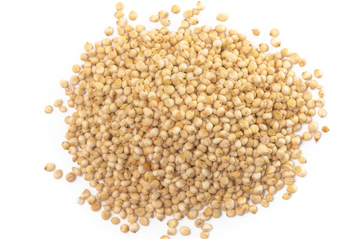Millets are a powerhouse of nutrition, offer a wealth of benefits for your health
MILLETS
A Nutrient-Packed Superfood


Sorghum Millet
Characteristics: Though not technically a millet, Jowar is often included in the millet category. It has a round, beige to brown grain.
Nutritional Benefits
Jowar is also known as “The King of Millets”, known for its nutritional prowess, offers a multitude of health benefits. This ancient grain not only supports growth and development but also strengthens immunity, combats cancer, aids digestion, and helps manage diabetes. Packed with essential nutrients such as iron, magnesium, copper, and vitamin B1, jowar is also a significant source of protein, making it a wholesome addition to any diet.
Nutritional Facts
Serving Size 100g
(Approx. Values)
Protein (g)
10
Fiber (g)
4
Minerals (g)
1.6
Iron (mg)
2.6
Calcium (mg)
54
Little Millet
Characteristics: Tiny, round grains that are often golden or pale in color. Used in a variety of dishes.
Nutritional Benefits
Little millet, renowned for its nutritional benefits, is rich in antioxidants that bolster immunity and fortify the body against infections and diseases. This versatile grain is also a valuable source of magnesium, crucial for maintaining healthy bones, and supporting muscle and nerve function.
For women, little millet offers additional benefits post-menopause by helping to combat heart ailments. Its fibre content aids in controlling high blood pressure and cholesterol levels, making it beneficial for cardiovascular health. Moreover, individuals dealing with gallstones can find relief with little millet due to its Fiber-rich composition.
Nutritional Facts
Serving Size 100g
(Approx. Values)
Protein (g)
7.7
Fiber (g)
7.6
Minerals (g)
1.5
Iron (mg)
9.3
Calcium (mg)
17


Foxtail Millet
Characteristics: Small, golden-yellow grains with a slightly nutty flavour. Known for its quick cooking time.
Nutritional Benefits
Foxtail millet boasts a plethora of health benefits, ranging from aiding in weight loss and managing diabetes to supporting pregnancy. Rich in vitamins and minerals, this grain also offers a delightful nutty flavour, making it an excellent substitute for rice or wheat in a variety of recipes. Its versatility and nutritional profile make foxtail millet a valuable addition to any balanced diet.
Nutritional Facts
Serving Size 100g
(Approx. Values)
Protein (g)
7.7
Fiber (g)
7.6
Minerals (g)
1.5
Iron (mg)
9.3
Calcium (mg)
17
FAQs
Do you have any questions?
What are the different or modern ways to consume millet foods?
Millet Breakfast Bowls, Millet Pasta, Millet Noodle, Millet Porridge, Millet Salad, Millet Stir-Fries, Millet Soup, Millet Flour Baked Goods, Millet-Based Snacks, Millet-Based Energy Balls, Millet Smoothies, Millet Stuffing.
Are millets a good option for people with diabetes?
Yes, millets are an excellent choice for people with diabetes; however, moderation is the key. They have a low glycemic index, which means they cause a slower, more gradual rise in blood sugar levels compared to high-glycemic foods. This helps in better blood sugar control and can be beneficial in managing type 2 diabetes also.
Which is better: wheat or millet?
Millet is a better option due to its superior nutritional profile, higher dietary fiber content, and gluten-free nature. In contrast, wheat contains gluten, which may not be suitable for individuals with gluten sensitivity.
How do millets compare to other grains in terms of gluten content?
Millets are naturally gluten-free, making them a great alternative for individuals with celiac disease or gluten sensitivity. Unlike wheat, barley, and rye, which contain gluten, millets can be safely consumed without causing gluten-related issues.
